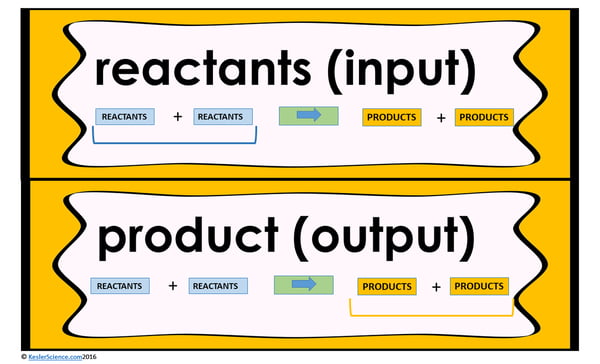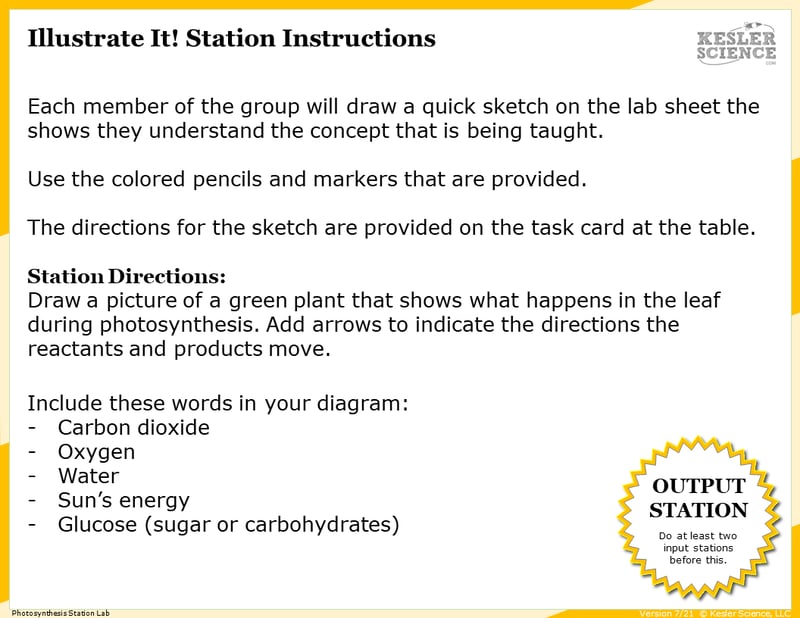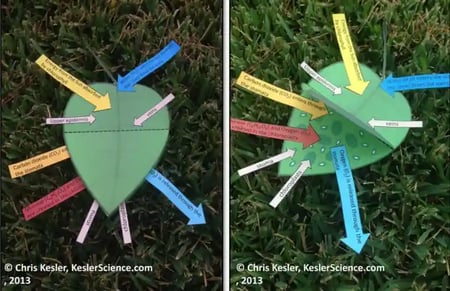Photosynthesis Lesson Plan – A Complete Science Lesson Using the 5E Method of Instruction
By the end of this lesson about photosynthesis, students will be able to construct a scientific explanation based on evidence about how radiant energy from the Sun is converted into chemical energy through the process of photosynthesis. They'll also be able to relate the Law of Conservation of Mass to the photosynthesis equation. Each of our lessons is designed using the 5E method of instruction to ensure maximum comprehension by the students. This well-thought out unit does the heavy lifting, giving teachers easy-to-implement, highly engaging lesson plans.
This blog will walk you through each of the steps and activities from the Photosynthesis 5E Lesson Plan.
ENGAGEMENT
Objective Introduction
At the beginning of the lesson, the class will do a Think-Pair-Share to discuss the objective.
Class Activity
- Review the Law of Conservation of Mass with students.
- Practice balancing the first two equations on the whiteboard.
- Reteach coefficients and subscripts as well as reactants and products.
Student Activity
- After practice, have students balance the last three equations on their own.
- Tell them they will be learning about a very important equation (photosynthesis) and how this chemical reaction occurs in green plants.
Example practice equations:
- ____Ag2O ____Ag + ____O2
- _____Cl2 + ____NaBr ____NaCl + ____Br2
- ____H2 + ____O2 _____H2O
- ____Mg + ____HCl ____H2 + MgCl2
- ____C6H14 + ____O2 _____CO2 + ____H2O


Afterwards, the teacher will help to clear any misconceptions their students may have about photosynthesis. A common but major misconception, for example, is that students often don't think of or understand photosynthesis as a chemical reaction. This extends to their own digestive system, too; students simply fail to associate the act of eating with something as new or sterile to them as chemical reactions.
Estimated Class Time for the Engagement: 20-30 minutes
EXPLORATION
This student-centered station lab is set up so students can begin to explore photosynthesis. With nine stations in total, you can introduce photosynthesis to your middle school students in a variety of ways! Four of these stations are considered input stations where students will learn new information about photosynthesis, and four of the stations are output stations where students will be demonstrating their mastery of the lesson's material. A bonus station offers challenges for your early finishers and independent learners. You can read more about how I set up the station labs here.
Watch It!
At this station, students will be watching a short video explaining photosynthesis. Students will then answer questions related to the video and record their answers on their lab station sheet. For example: During photosynthesis, radiant energy is converted into what kind of energy? Xylem helps plants receive water and nutrients to the entire plant. What body system is like this for humans? After watching the video, describe why photosynthesis is much slower in underwater plants.
Read It!
This station will provide students with a one-page reading about photosynthesis and all the factors included in this chemical reaction. There are four follow-up questions that the students will answer to demonstrate their comprehension of the reading material.
Explore It!
Students will be working in pairs to better understand photosynthesis. In this station, students interact with cards to create the photosynthesis equation and explain the reactants and products. Students will follow the steps and record their observations on their lab sheet.
Research It!
The research station will allow students to explore a YouTube animation video that helps them to understand photosynthesis. Students will be instructed to complete a few tasks and record answers on their lab sheets.
Organize It!
Students at this station will match the sets of cards. Half of the cards contain descriptions of factors of photosynthesis and the other half will have the name of those factors. Once students have completed their organization, the teacher will check their understanding.
Illustrate It!
Your visual students will love this station. Students are to draw a picture that demonstrates their knowledge of photosynthesis. Students will draw a leaf and label their diagram with carbon dioxide, oxygen, water, the Sun’s energy and glucose.

Write It!
Students who can answer open-ended questions about the lab truly understand the concepts that are being taught. At this station, the students will be answering three task cards: Why is photosynthesis described as a chemical reaction? If an asteroid created enough dust to block the Sun, what would be the effect on green plants as well as other life here on Earth? Write the photosynthesis equation using either words or chemical symbols. Extra kudos for balancing it.
Assess It!
The Assess It station is where students will go to prove mastery over the concepts they learned in the lab. The questions are set up in a standardized format with multiple choice answers. Some questions include: Which of the following does not happen during photosynthesis? In the photosynthesis equation, what does the subscript number mean? Which is not an example of radiant energy? Which is the correct combination for the photosynthesis equation? (not balanced)
Challenge It! - Bonus Station
Early finishers and advanced students will love the extension activities in this station. Four activity choices offer them ways to expand their learning through mini-games and mini-projects.
Estimated Class Time for the Exploration: One or two 45-minute class periods
EXPLANATION
The explanation activities will become much more engaging for your class once they’ve completed the exploration station lab. During the explanation piece of the lesson, the teacher will be clearing up any misconceptions their students may have about photosynthesis with a variety of materials. These materials include on-level and modified versions of the interactive presentation (may be used individually or projected), anchor charts, and paper or digital interactive notebook activities. If you have students that need modified notes, the 5E lessons come equipped to help give every student access to the lesson.

Interactive notebook samples: Above-left is a digital INB activity slide; above-right is an example of the paper INB activities.
The students will also be interacting with their journals while taking notes from the PowerPoint. If you have students that need modified notes, the 5E lessons come equipped to help give every student access to the lesson.
Estimated Class Time for the Exploration: Two or three 45-minute class periods
ELABORATION
The elaboration section of the 5E method of instruction gives students choices that allow them to prove they’ve mastered the concepts behind the lesson. When students are given a choice, they’re much more enthusiastic and invested in the project than they are when their teachers choose their projects for them. There are a total of nine choices to demonstrate understanding of photosynthesis. A separate set of choices that offer more teacher support are also available for students that need them. Rubrics guide students to doing their best work and assist in grading.

Estimated Class Time for the Elaboration: Two or three 45-minute class periods (can also be used as an at-home project)
EVALUATION
The final piece of the 5E model is to evaluate your students' comprehension. Included in every 5E lesson is a homework assignment, assessment, and modified assessment. Research has shown that homework needs to be meaningful and applicable to real-world activities in order to be effective. When possible, I like to give open-ended assessments to truly gauge the student’s comprehension.
Estimated Class Time for the Elaboration: One 45-minute class period
DOWNLOAD THE FULL LESSON NOW
Download Over $100 in FREE Resources
For Middle School Science
Simply create a login below and gain immediate access to a selection of our Kesler Science product line worth $100 - for FREE. There's a full version of every product type! You'll also join tens of thousands of middle school science teachers who receive timely tips and strategies straight to their inbox.







